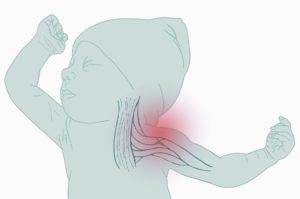What is Erb’s palsy?
Erb’s palsy, also called brachial plexus palsy or Erb-Duchenne palsy, develops when an infant’s neck is stretched to one side during a difficult delivery.
The brachial plexus is a network of nerves that runs down the spine. It gives feeling and control to muscles in the arms, shoulders, elbows, wrists, and hands.
When these nerves are damaged during childbirth, it may result in temporary or permanent paralysis of the arm.
Erb’s palsy vs. other types of palsy
Brachial plexus birth palsy is very different from cerebral palsy. Erb’s palsy is caused by damage to neck nerves, whereas cerebral palsy is caused by damage to the brain.
Erb’s palsy also differs from other brachial plexus injuries such as Klumpke’s palsy. This condition is uncommon in babies and causes paralysis of the lower brachial plexus, affecting hand muscles. Brachial plexus palsy affects voluntary movement in the upper arm and range of motion in the lower arm.
If you believe your child may have suffered from Erb’s palsy, speak with one of our registered nurses. We can help you determine the cause of your child’s birth injury.
Types of Erb’s palsy
There are four main types of brachial plexus palsy. Doctors determine the type of brachial plexus palsy based on the degree of damage to the brachial plexus nerve.
Learn more about the different Erb’s palsy types below.
Neuropraxia
Neuropraxia is the most common type of Erb’s palsy and occurs when a nerve is stretched but does not tear at all. Neuropraxia can cause a burning or stinging sensation and usually clear up on its own by 3 months of age.
Neuroma
Neuromas are more severe than neuropaxias. When neuromas occur, scar tissue forms as it heals itself from the stretching and places pressure on the other healthy network of nerves. Generally, children with neuroma Erb’s palsy partially heal.
Rupture
Ruptures occur when the brachial plexus nerve is torn. Ruptures require more intensive medical care since they will not heal. This injury usually requires surgery to graft the damaged nerve fibers back together.
Avulsions
Avulsions are the most severe type of nerve injury and they occur when a nerve is completely torn from the spinal cord. This can cause permanent paralysis or muscle weakness in the affected arm. It can also lead to Horner’s syndrome and cause difficulty breathing, drooping eyelids, and small pupils.
Surgery may help to repair avulsions, but the affected nerve cannot be reattached to the spinal cord.
The best and only way to determine which type of brachial palsy your child may have is to consult with a doctor. Once diagnosed, you can determine the best treatment options for your child’s condition.
To learn more about the different types of brachial plexus palsy and available treatment options, download our free Erb's Palsy Guide.
Causes of Erb’s palsy
Erb’s palsy is often caused by excessive pulling or stretching of an infant’s head and shoulders during a difficult or prolonged delivery. Erb’s palsy can develop if an infant’s head and neck are pulled to the side at the same time as the shoulders pass through the birth canal.
During difficult childbirths, doctors may have to move quickly to deliver the baby and may exert extra force to get the child out of the birth canal. This can stretch the baby’s neck and may result in Erb’s palsy.
Brachial plexus palsy can also develop due to the baby being in an awkward position in the womb.
This can occur if an infant’s shoulder is stuck behind the mother’s pubic bone when their head drops into the birth canal. This can stretch the brachial plexus nerves as the baby’s head is pushed out.
The risk of a child developing Erb’s palsy nearly triples if they develop shoulder dystocia during birth. Shoulder dystocia occurs when an infant’s head is delivered but both of their shoulders get stuck inside the mother’s womb.
There are several other risk factors that can increase the chances of a child developing Erb’s palsy.
Risk factors of Erb’s palsy include:
- C-section (cesarean section)
- Excessive maternal weight gain
- Forceful pulling on the arm
- Large infant size or high birth weight
- Maternal diabetes
- Second stage of labor lasting over an hour
- Small or abnormal maternal pelvis shape
- Use of assistive delivery tools such as forceps or vacuum extractor
- Other forms of medical negligence
Many causes of Erb's palsy stem from medical negligence. This can occur when a doctor, nurse, or another medical professional makes serious medical errors that cause injury to the baby.
If you believe your child developed Erb’s palsy due to medical negligence, you may be eligible to take legal action. We'll review your case for free to see if you qualify for financial compensation.
Signs & symptoms of Erb’s palsy


Symptoms are often recognizable at birth, but the severity of nerve damage and the limits on a child’s movement may not be determined until the child is 3 to 6 months old.
The most common symptoms of Erb’s palsy include:
- Arm hangs by the side and wrist rotates inward (waiter's tip)
- Decreased grip strength
- Limited motion of the arm
- Numbness in arm
- Partial or total paralysis of the arm
- Weakness in the arm
It is important to contact your doctor if your child is showing any of the signs listed above. The sooner you get a diagnosis, the sooner your child can get treatment.
Learn more about signs and symptoms by downloading our free comprehensive guide to Erb's palsy.
Erb’s palsy treatment
Some mild cases of paralysis caused by Erb’s palsy in newborns can resolve on their own within a few months, but more severe cases require more in-depth treatment such as therapy or surgery.
Your child may require more intensive treatment if their range of movement and development is still delayed after six months.
Learn more about Erb’s palsy treatments below.
Physical therapy
One of the main treatment methods for brachial plexus palsy is physical therapy.This therapy helps to improve stiffness and immobility in a child’s arms or shoulders. Therapists will use massage techniques, motion exercises, and exercise equipment to improve movement and strength in the affected arm.
Babies can start home physical therapy as early as 3 weeks old.
Occupational therapy
Occupational therapy is often used in cases of Erb’s palsy that have not improved on their own after 2 to 4 months.Occupational therapy can help a child develop the strength to perform everyday activities, such as picking up a toy or bottle. An occupational therapist will use a range of movement exercises to improve joint function and muscle tone.
Surgery
Children with severe cases of Erb’s palsy will usually require surgery to repair nerve damage and paralysis in the arm, hand, elbow, or shoulder. It is important to get surgery as soon as possible since postponing Erb’s palsy surgery can lower the chance of complete recovery.The main type of surgery used to treat this condition is a nerve transfer. Doctors remove a healthy nerve from another area to attach it to a damaged nerve.
In some cases, a tendon transfer may also be performed. This involves taking a tendon from another part of the body and moving it to the affected arm to improve mobility.
Our team is standing by to learn more about your child’s injury and see if medical negligence is to blame. Get in touch with us to speak to one of our experienced nurses today.
Take legal action for Erb’s palsy today
Doctors, nurses, and other professionals in the delivery room are trained to safely deliver babies without complications. Unfortunately, many instances of brachial plexus palsy are caused by medical negligence and could have been prevented with proper care.
You should not be responsible for paying for your child’s Erb’s palsy treatment if their condition could have been avoided. Thankfully, there are financial aid options available to help your family afford the treatment your child deserves.
You may be eligible for financial compensation through a lawsuit. Get a free case evaluation today to see if you qualify to file a medical malpractice lawsuit.

 Erb’s palsy, also called brachial plexus palsy or Erb-Duchenne palsy, develops when an infant’s neck is stretched to one side during a difficult delivery.
Erb’s palsy, also called brachial plexus palsy or Erb-Duchenne palsy, develops when an infant’s neck is stretched to one side during a difficult delivery.

